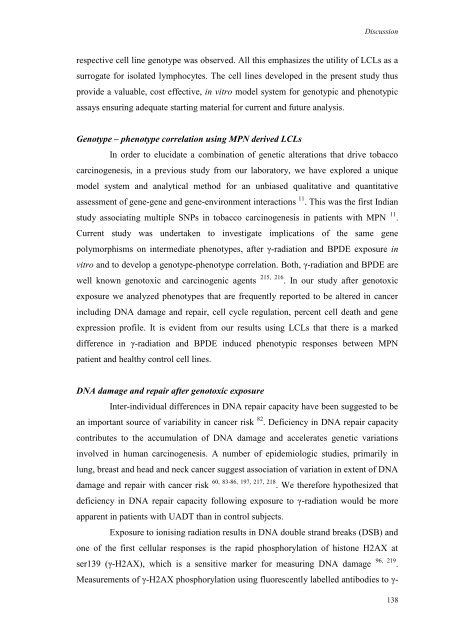LIFE09200604007 Tabish - Homi Bhabha National Institute
LIFE09200604007 Tabish - Homi Bhabha National Institute
LIFE09200604007 Tabish - Homi Bhabha National Institute
You also want an ePaper? Increase the reach of your titles
YUMPU automatically turns print PDFs into web optimized ePapers that Google loves.
Discussion<br />
respective cell line genotype was observed. All this emphasizes the utility of LCLs as a<br />
surrogate for isolated lymphocytes. The cell lines developed in the present study thus<br />
provide a valuable, cost effective, in vitro model system for genotypic and phenotypic<br />
assays ensuring adequate starting material for current and future analysis.<br />
Genotype – phenotype correlation using MPN derived LCLs<br />
In order to elucidate a combination of genetic alterations that drive tobacco<br />
carcinogenesis, in a previous study from our laboratory, we have explored a unique<br />
model system and analytical method for an unbiased qualitative and quantitative<br />
assessment of gene-gene and gene-environment interactions 11 . This was the first Indian<br />
study associating multiple SNPs in tobacco carcinogenesis in patients with MPN 11 .<br />
Current study was undertaken to investigate implications of the same gene<br />
polymorphisms on intermediate phenotypes, after γ-radiation and BPDE exposure in<br />
vitro and to develop a genotype-phenotype correlation. Both, γ-radiation and BPDE are<br />
well known genotoxic and carcinogenic agents 215, 216 . In our study after genotoxic<br />
exposure we analyzed phenotypes that are frequently reported to be altered in cancer<br />
including DNA damage and repair, cell cycle regulation, percent cell death and gene<br />
expression profile. It is evident from our results using LCLs that there is a marked<br />
difference in γ-radiation and BPDE induced phenotypic responses between MPN<br />
patient and healthy control cell lines.<br />
DNA damage and repair after genotoxic exposure<br />
Inter-individual differences in DNA repair capacity have been suggested to be<br />
an important source of variability in cancer risk 82 . Deficiency in DNA repair capacity<br />
contributes to the accumulation of DNA damage and accelerates genetic variations<br />
involved in human carcinogenesis. A number of epidemiologic studies, primarily in<br />
lung, breast and head and neck cancer suggest association of variation in extent of DNA<br />
damage and repair with cancer risk 60, 83-86, 197, 217, 218 . We therefore hypothesized that<br />
deficiency in DNA repair capacity following exposure to γ-radiation would be more<br />
apparent in patients with UADT than in control subjects.<br />
Exposure to ionising radiation results in DNA double strand breaks (DSB) and<br />
one of the first cellular responses is the rapid phosphorylation of histone H2AX at<br />
ser139 (γ-H2AX), which is a sensitive marker for measuring DNA damage 96, 219 .<br />
Measurements of γ-H2AX phosphorylation using fluorescently labelled antibodies to γ-<br />
138

















